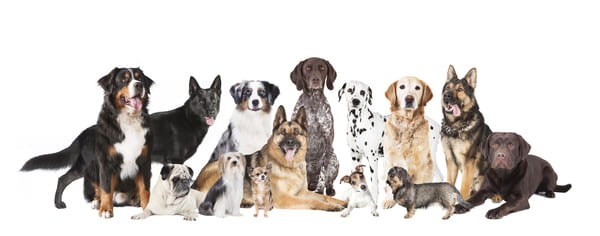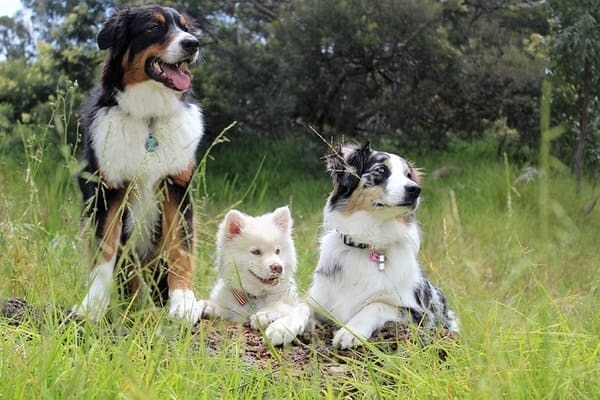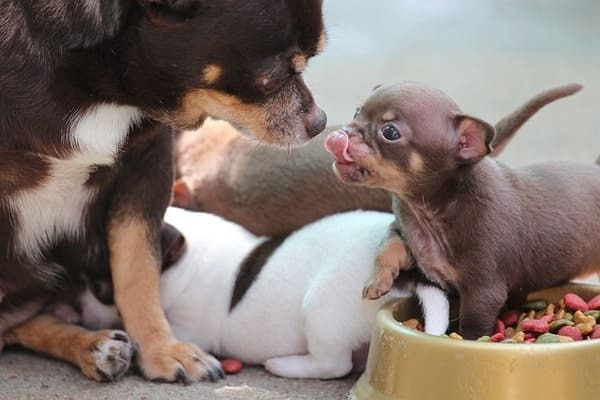















 Back
Back
Why Are There So Many Dog Breeds?
From huge Mastiffs to tiny Chihuahuas, dogs come in a range of shapes and sizes. How did we get all of these breeds throughout the generations? Animalia explores.

Writer Animalia Team

Can you name every type of dog? Considering that the American Kennel Club recognizes nearly 200 breeds and international organizations count more than 300, the answer is probably no. While everybody knows ubiquitous breeds like the Labrador Retriever, the Poodle, or the Corgi, more obscure pups like the Pouli have a smaller (though no less passionate) following. Why are there quite so many breeds? That’s largely the result of human intervention. Since dogs were first domesticated, humans have labored to develop animals with the ideal qualities. Selective breeding contributed to the emergence of avid hunters, strong laborers, and adorable companions.
The evolution of man’s best friend
Experts agree that the dogs we know and love today descended from wolves thanks to a domestication process that first started tens of thousands of years ago. Just about as soon as humans started calling canines their companions, they began to breed dogs to suit their needs and tastes.
Until fairly recently, the science community’s understanding of these long evolutionary processes was lacking. Decades of research by Studying more than 1300 dogs over more than twenty years and collecting countless DNA samples has recently helped the National Human Genome Research Institute’s Elaine Ostrander and Heidi Parker produce perhaps the most detailed canine family tree ever.
23 Clades: the canine family tree as we understand it
In 2017, Ostrander and Parker’s efforts reached a milestone when the duo published some of their findings in Cell Reports. Analyzing dogs from more than 160 breeds, the researchers identified 23 groups of breeds called clades. Taking a closer look at clades and their relationship to one another helps paint a picture of how new breeds have arisen – particularly in the last few centuries.

The dogs included in each clade share a number of common characteristics with their “pack members.” Within one clade, you’ll find several dogs known for their hunting prowess. In another, you’ll see a group of strong dogs known for their skills as guardians. Some particularly popular breeds appear in more clades than one, suggesting how their DNA spread across continents and contributed to the rise of other dog breeds. The pug is one notable example of an historically significant breed making an evolutionary impact throughout the centuries.
In addition to giving canine researchers a better sense of how new breeds come to be, clades could also guide the efforts of vets. Reviewing clades could hold the key to identifying heritable diseases a dog might be at risk of developing and mounting an effective response.
Bred for a purpose: dogs born for specific jobs
Throughout Today’s AKC breed groups make reference to the purposeful breeding of many recognizable breeds:
Herding Group
The short, stubby-legged Corgi has won the hearts of dog lovers everywhere thanks to its unusual appearance. Corgis were not, however, bred for aesthetics alone. Like their peers in the Herding Group, these dogs are adept at guiding and controlling much larger livestock animals. Other Herding Group members include the Australian Shepherd, the Border Collie, and the German Shepherd.
Hound Group
Historically favored for their stamina and strong senses of smell, the diverse Hound Group includes dogs like the Bloodhound, Beagle, and Basset Hound. All were bred in part to assist with tracking and hunting.
Sporting Group
This group of likable and athletic pups includes a number of breeds whose names suggest their roles as companions to hunters. The Chesapeake Bay and Golden Retrievers, for example, are named for their retrieving skills. As opposed to dogs who help track prey, retrievers “fetch” game birds, water fowl, and other animals after they are shot.
Terrier Group
Dogs from the Terrier Group range in size, but were generally bred to hunt and kill vermin. The smallest of the group’s dogs could track tiny prey through burrows and tunnels.
Toy Group
Adorable Toy Group dogs were bred to serve as cute companions and still stand out for their diminutive proportions and delightful appearances. Breeds such as the Chihuahua and Shih Tzu are often a particular favorite of animal lovers trying to comfortably share small homes and apartments with pets.

Working Group
The Working Group’s collection of strong, sturdy dogs have historically performed a range of functions for their human companions. Siberian Huskies were bred to pull sleds, Saint Bernards aided in mountaintop rescues, and pooches like the Doberman Pinscher were bred for qualities that make them imposing guard dogs.
The Non-Sporting and Miscellaneous Groups collect some of the stray breeds who don’t quite fit into the above categories.
Bred to suffer
60% of Golden Retrievers die of cancer. 32% of King Charles Spaniels have skulls that are too small for their brain. Great Danes are so big that their heart can’t support their body. Bulldogs’ heads are so big, they can only give birth by c-section. Pugs are 54 times more likely to suffer from severe breathing problems compared with non-pugs.
Turns out, our insistence that these dogs will live according to our arbitrary standards is causing significant health issues due to the lack of genetic diversity.
Why are there more dog breeds than cat breeds?
Cat lovers and dog lovers are equal in their passionate affection for their chosen pets. Still, the long-term breeding processes for these animals have been much different. The canine community is – as we’ve covered – incredibly diverse. There are comparatively few varieties of feline, just 42 per the Cat Fanciers’ Association.
Dogs’ usefulness While many types of canines were bred to perform certain tasks, there are no working cat breeds. This fact has potentially contributed to the relatively homogenous feline population. The dog’s relative sociability plays a role too. Your dog’s lupine ancestors were social animals, used to hunting and living in packs and building strong bonds. Cats and their ancient relatives were more solitary. This helps explains the ease with which lost or abandoned cats seem to forget their human relationships and return to independent, itinerant life.
Cats who run away can quickly give birth to kittens who’ll grow up totally feral and give birth to future generations of their own. Without human contact during their early days, these cats will have no inclination to interact with people and play housecat.
Pet insurance coverage to suit every breed
Animalia dog insurance covers breed-specific, hereditary, and congenital conditions. That means hip dysplasia, cancer, allergies, breathing issues, skin disease…you name it, it’s covered.
Learn more about pet insurance coverage and request your quote today.





We offer the most comprehensive coverage
out there
Having Animalia is like a top-of-the-line
Rolls-Royce with a swimming
pool in the trunk.



Get your pet insurance quote
Pet type
- Dog
- Cat
What is your pet's name?
Zip code





